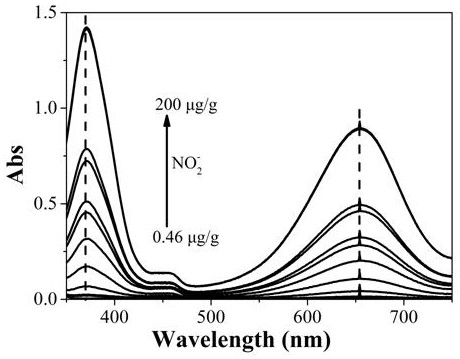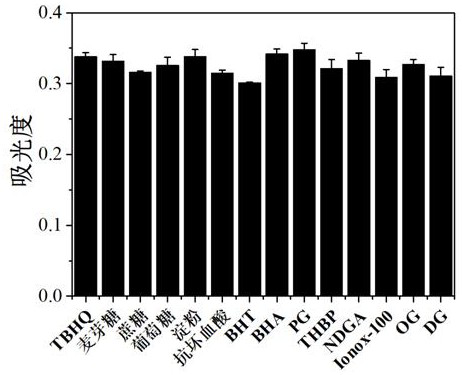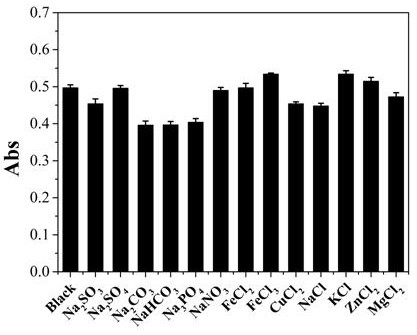Method for quickly detecting tert-butylhydroquinone in food
A tertiary butyl hydroquinone, food technology, applied in the field of chemical analysis and detection, can solve the problems of catalytic oxidation, which is rarely reported, and achieve the effect of fast reaction, high sensitivity and good reproducibility
- Summary
- Abstract
- Description
- Claims
- Application Information
AI Technical Summary
Problems solved by technology
Method used
Image
Examples
Embodiment 1
[0022] Embodiment 1: the mensuration of TBHQ in the soybean oil sample
[0023] 1. Preparation of Cu-I / CDs: 0.1g CuCl 2 , 0.4g of 3-iodo-L-tyrosine was added to 40mL of ultrapure water, mixed and dissolved, then 100μL of ethylenediamine was added, ultrasonicated for 10min, and transferred to a polytetrafluoroethylene reactor, heated at 180°C for 8h, naturally After cooling, first filter with a filter membrane with a pore size of 0.22 μm, and then perform dialysis treatment with a dialysis bag with a molecular weight cut-off of 3000 Da for 24 hours to obtain water-soluble Cu-I / CDs;
[0024] 2. Gold nanoparticles prepared by Cu-I / CDs reduction: add 2 mL of polypropyleneimine with a concentration of 0.25 g / mL to 20 mL of ultrapure water, add 80 μL of chloroauric acid with a mass concentration of 1% under stirring, and then add 200 μL Cu-I / CDs, after stirring for 30min, the solution turns reddish brown, namely the gold nanometer prepared by reduction of Cu-I / CDs.
[0025] 3. Pre...
Embodiment 2
[0035] Example 2: Determination of TBHQ in sunflower oil samples
[0036] 1. Preparation of Cu-I / CDs: 1 g CuCl 2 Dissolve 3g of 3-iodo-L-tyrosine in 500mL of purified water, mix and dissolve, add 900μL of ethylenediamine, ultrasonicate for 15min, transfer to a polytetrafluoroethylene reactor, heat at 180°C for 10h, cool naturally, and Filter with a filter membrane with a pore size of 0.22 μm, and then perform dialysis treatment with a dialysis bag with a molecular weight cut-off of 3000D for 24 hours to obtain water-soluble Cu-I / CDs;
[0037] 2. Preparation of gold nanoparticles obtained by reduction of Cu-I / CDs: 2 mL of 0.25 g / mL polypropyleneimine, 18 mL of ultrapure water, 90 μL of 1% chloroauric acid was added under stirring, and then 190 μL of Cu-I / CDs, after stirring for 35min, the solution turned reddish brown, and the obtained Cu-I / CDs were reduced to obtain gold nanometers;
[0038] 3, tert-butylhydroquinone working curve is made with embodiment 1;
[0039] 4. Det...
Embodiment 3
[0042] Example 3: Determination of TBHQ in Cookies
[0043] 1, the preparation of Cu-I / CDs is the same as embodiment 1;
[0044] 2, the preparation of the gold nanometer that Cu-I / CDs reduction makes is the same as embodiment 1;
[0045] 3, tert-butylhydroquinone working curve is made with embodiment 1;
[0046] 4. Determination of TBHQ in cookies
[0047] (1) Sample treatment: Weigh 5.00g of evenly powdered biscuit sample into a 100mL Erlenmeyer flask, add 8mL of absolute ethanol, vortex mix for 1min, then ultrasonically extract for 15min, let stand for stratification, and draw the supernatant into a 50mL centrifuge tube , the residue was extracted twice with 8 mL of absolute ethanol each time; the combined supernatant was added to a 50 mL centrifuge tube with 1 g of neutral alumina, vortexed for 1 min, and centrifuged at 3000 r / min for 8 min, and the supernatant was pipetted into a 25 mL capacity In the bottle, dilute to volume with absolute ethanol, shake well, and obtai...
PUM
| Property | Measurement | Unit |
|---|---|---|
| size | aaaaa | aaaaa |
Abstract
Description
Claims
Application Information
 Login to View More
Login to View More - Generate Ideas
- Intellectual Property
- Life Sciences
- Materials
- Tech Scout
- Unparalleled Data Quality
- Higher Quality Content
- 60% Fewer Hallucinations
Browse by: Latest US Patents, China's latest patents, Technical Efficacy Thesaurus, Application Domain, Technology Topic, Popular Technical Reports.
© 2025 PatSnap. All rights reserved.Legal|Privacy policy|Modern Slavery Act Transparency Statement|Sitemap|About US| Contact US: help@patsnap.com



